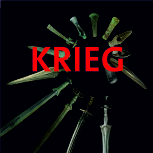Exhibition in Vienna: "War. On the Trails of Evolution" / "Krieg. Auf den Spuren einer Evolution" (Wien)
How old is "war"?
100 years after the end of the First World War and 400 years after the beginning of the Thirty Years' War, the exhibition "War. On the Trails of Evolution" at the Natural History Museum Vienna (NHM) uses archaeological and anthropological research to document the development of armed conflicts and some of the most brutal battles in human history.
The exhibition was created in cooperation with the State Museum of Prehistory in Saxony-Anhalt. It shows that "the earliest conflicts between humans in the Stone Age could have been the precursors of war", says Christian Köberl, General Director of the NHM.
Still growing field of research

The exhibition draws on these findings when it shows how original hunting or agricultural tools were transformed into weapons, how duels degenerated into battles or how the mythical war hero turned into cannon fodder. "The point is to use archaeology and anthropology to gain information about past wars and the fate of their victims," explains Köberl. The exhibition also confronts visitors with the present, for example with the Global Peace Index, which documents the peaceableness of nations.
More than 6000 dead in six hours
The horrors and traumas of war are particularly evident in the example of a mass grave dating from 1632, which bears witness to a battle during the Thirty Years' War at Lützen in Saxony: In less than six hours, the forces of Sweden and the Germanies fought against each other. More than 6000 people lost their lives in the fields around the small town between Leipzig and Naumburg. "The focus is above all on people, both active participants and victims and their fates," says Christian Köberl.
Picture source and more information: Naturhistorisches Museum Wien
Congratulations @fastio! You have completed the following achievement on the Steem blockchain and have been rewarded with new badge(s) :
Click here to view your Board of Honor
If you no longer want to receive notifications, reply to this comment with the word
STOPDo not miss the last post from @steemitboard: